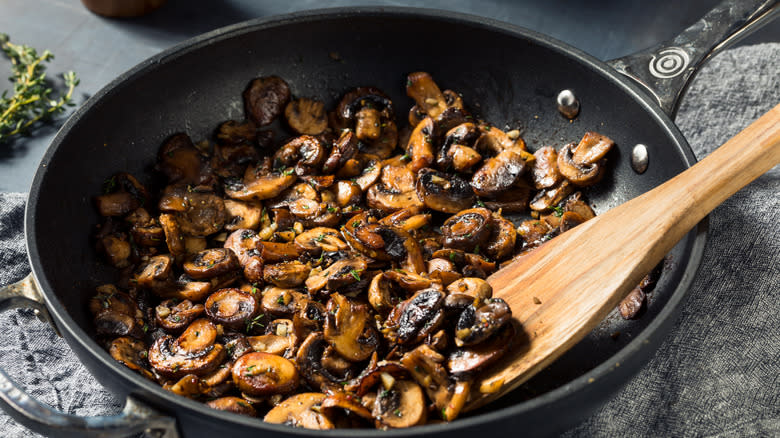This One Addition Gives Your Homemade Canned Mushrooms Better Color

Canning surplus homegrown or store-bought fruits and vegetables makes them last through the year. While mushrooms may not be a typical garden veggie, they'll benefit just as much from canning, particularly if you want to preserve some bountiful fungi that you found in season in the farmers market or grocery store. But before you begin, source the addition that'll help your mushrooms maintain their earthy brown hue: ascorbic acid.
Also known as vitamin C, ascorbic acid is well-known among home canners as a secret weapon to combat discoloration in mushrooms, potatoes, and stone fruit. It's also used in meat products. Ascorbic acid both acts as a preservative and keeps the mushrooms from oxidizing, that is, browning in response to oxygen exposure. As an antioxidant it slows down the oxidization process. The goal is to limit oxygen exposure when canning foods with proper sealing and submergence in the canning liquid, but even before you can mushrooms they're exposed to oxygen.
Ascorbic acid is therefore needed, and a little bit goes a long way. It is added as a powder or as a vitamin C tablet along with salt to freshly boiled mushrooms in their canning jar before adding hot water and sealing. A pint of canned mushrooms requires one-eighth of a teaspoon of ascorbic acid powder, or a 500 milligram vitamin C tablet. Vitamin C tablets are widely available, and pure ascorbic acid powder is available online. During the summer canning season, ascorbic acid can also be found at grocery stores.
Read more: 13 Simple Tricks To Pick The Best Fresh Fruit Every Time
How To Use Canned Mushrooms

Now that you've safeguarded against browning, you'll need a few more tips to breathe textural and flavorful life into canned mushrooms. While boiling mushrooms for canning may impart a rubbery texture and mute their umami-rich flavor, you can revive their desirable qualities by incorporating them into more complex dishes, marinating them, or sauteing them.
If you're going to use them as a standalone ingredient in a saute, draining and drying canned mushrooms is especially important. By letting drained canned mushrooms sit and dry out for at least ten minutes, you'll help them absorb any flavors you saute them with. Both butter and olive oil are great savory compliments to bring out the umami-richness in mushrooms. You could also dry saute your mushrooms or sear them to impart a meatier flavor and texture.
Draining and drying canned mushrooms also readies them for a marinade. You can use the same canning jar to submerge them in a tangy, rich marinade with balsamic vinegar, garlic, olive oil, and oregano. Balsamic marinated mushrooms will taste delicious in this veggie antipasti Italian pasta salad. You could also chop them up and spoon them over slices of baguette, top them with shaved parmesan or shredded mozzarella, and bake them for a more substantial twist on these balsamic marinaded bruschetta. Canned mushrooms are also good additions to gravies, casseroles, omelets, stews, and soups.
Read the original article on Tasting Table.


